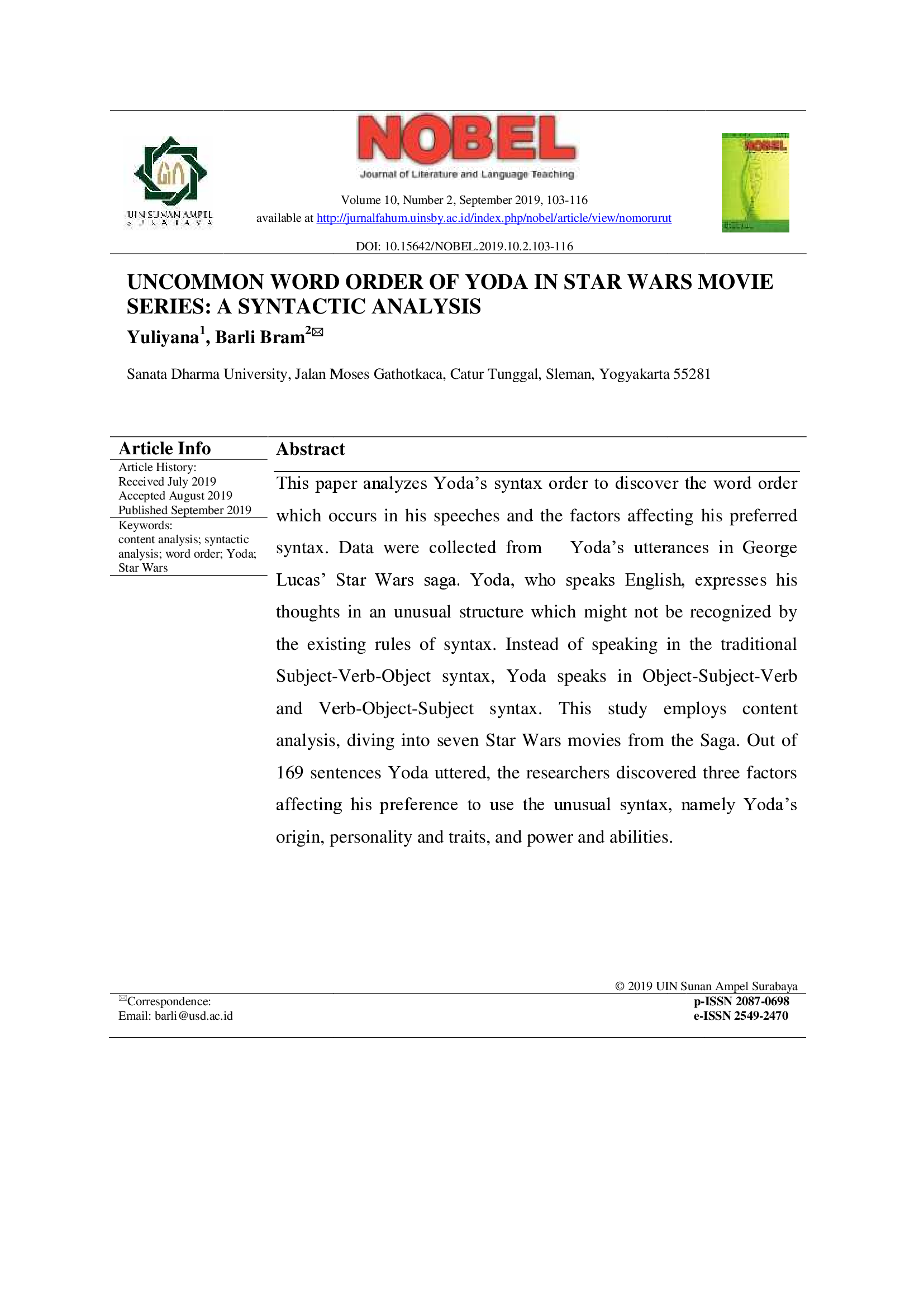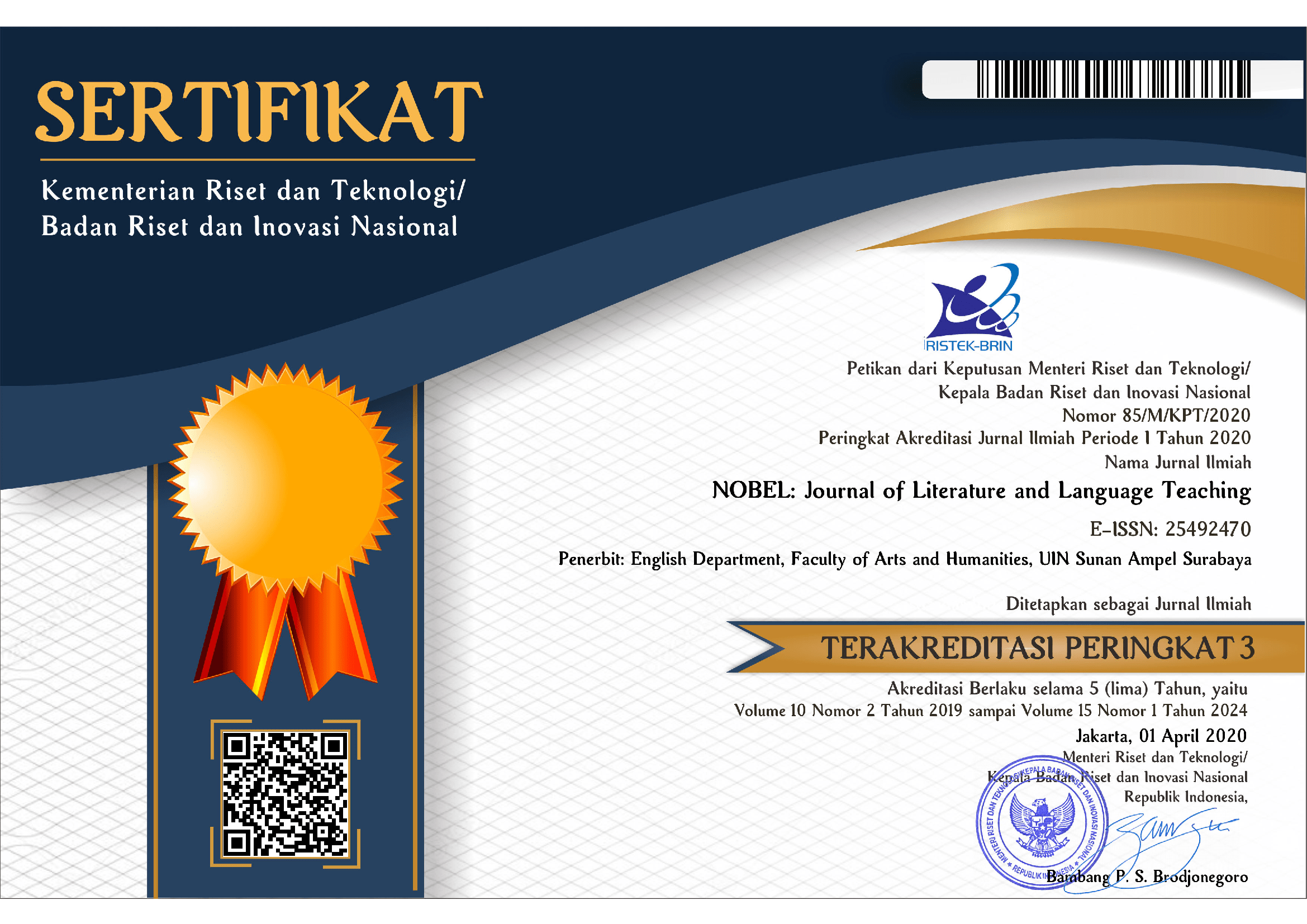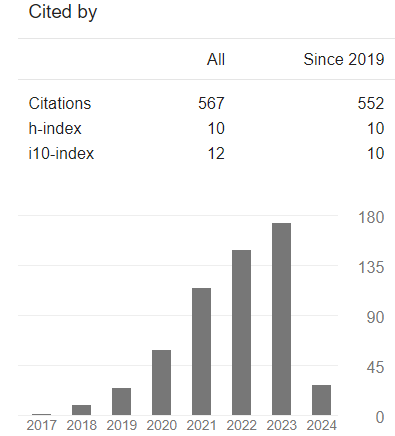Uncommon Word Order of Yoda in Star Wars Movie Series: A Syntactic Analysis
DOI:
https://doi.org/10.15642/NOBEL.2019.10.2.103-116Keywords:
content analysis; syntactic analysis; word order; Yoda; Star WarsAbstract
This paper analyzes Yoda's syntax order to discover the word order which occurs in his speeches and the factors affecting his preferred syntax. Data were collected from Yoda's utterances in George Lucas' Star Wars saga. Yoda, who speaks English, expresses his thoughts in an unusual structure which might not be recognized by the existing rules of syntax. Instead of speaking in the traditional Subject-Verb-Object syntax, Yoda speaks in Object-Subject-Verb and Verb-Object-Subject syntax. This study employs content analysis, diving into seven Star Wars movies from the Saga. Out of 169 sentences Yoda uttered, the researchers discovered three factors affecting his preference to use the unusual syntax, namely Yoda's origin, personality and traits, and power and abilities.
Downloads
References
Ary, D., Jacobs, L. C., & Razavieh, A. (2002). Introduction to Research in Education (6th ed.). Wadsworth: Thomson Learning.
Ary, D., Jacobs, L. C., Sorensen, C., & Razavieh, A. (2010). Introduction to Research in Education (8th ed.). Belmont, CA: Wadsworth Cengage Learning.
Bailey, L. R. (2010) Sentential word order and the syntax of question particles. Newcastle Working Papers in Linguistics, 16
Bauer, L. (2007). The Linguistics Student’s Handbook. Edinburgh: Edinburgh University Press.
Candan et al. (2012). Language and age effects in children’s processing of word order. Cognitive Development 27 (1) 205–221. doi:10.1016/j.cogdev.2011.12.001
Chomsky, N. (1965) Aspects of the Theory of Syntax. Massachusetts Institute of Technology.
Coon, J. (2010). VOS as predicate fronting in Chol. Lingua, 120(2), 354–378. doi:10.1016/j.lingua.2008.07.006
Creswell, J. (2007). Qualitative Inquiry & Research Design: Choosing Among Five Approaches, 2nd ed. California: Sage Publication
Culbertson, J., Smolensky, P., & Legendre, G. (2012). Learning biases predict a word order universal. Cognition, 122(3), 306–329. doi:10.1016/j.cognition.2011.10.017
Damian, M.F., & Dumay, N. (2007). Time pressure and phonological advance planning in spoken production. Journal of Memory and Language, 57, 195–209.
Derbyshire, D. C. (1977). Word order universals and the existence of OVS languages. Linguistic Inquiry, 8(3), 590-599.
Djami, C. B. N., Setiawan, N. A., & Bram, B. (2019). The use of notional and grammatical agreement of semester 1 English language education study program’s students. The 5th International Language and Language Teaching Conference Proceedings. Sanata Dharma University, Yogyakarta. Retrieved from https://drive.google.com/file/d/1oQpcFi5hZoCR95C4yuEc3rxhDoiJpcLT/view
Dryer M.S. (2009) The branching direction theory of word order correlations revisited. Studies in Natural Language and Linguistic Theory, 76 https://doi.org/10.1007/978-1-4020-8825-4_10
Dryer, M. S. (2007). Word order. Language Typology and Syntactic Description, 1, 61-131.
Dryer, M. S. (2008a). The branching direction theory of word order correlations revisited. In Scalise, S., Magni, E., & Bisetto, A. (Eds.). Universals of Language Today. Berlin: Springer.
Dryer, M. S. (2008b). Word order in Tibeto-Burman languages. Linguistics of the Tibeto-Burman Area, 31(1), 1-83. Retrieved from https://www.acsu.buffalo.edu/~dryer/DryerTibetoBurmanWordOrder.pdf
Fromkin, V., Rodman, R., & Hyams, N. (2003). An Introduction to Language (7th ed.). Heinle: United States of America.
Gell-Mann, M., & Ruhlen, M. (2011). The origin and evolution of word order. Proceedings of the National Academy of Sciences, 108(42), 17290–17295. doi:10.1073/pnas.1113716108
Gertner, Y., Fisher, C., & Eisengart, J. (2006). Learning words and rules: Abstract knowledge of word order in early sentence comprehension. Psychological Science, 17(8), 684–691.
Gervain, J., Nespor, M., Mazuka, R., Horie, R., & Mehler, J. (2008). Bootstrapping word order in prelexical infants: A Japanese–Italian cross-linguistic study. Cognitive Psychology, 57(1), 56–74. doi:10.1016/j.cogpsych.2007.12.001
Greenberg, J. (1963). Some universals of grammar with particular reference to the order of meaningful elements. In J. Greenberg (Ed.), Universals of Language. Cambridge, MA: Massachusetts Institute of Technology.
Hannay, M. (1991). Pragmatic function assignment and word order variation in a functional grammar of English. Journal of Pragmatics, 16(2), 131-155. https://doi.org/10.1016/0378-2166(91)90077-B.
Hawkins, J. (1983). Word Order Universals. New York: Academic.
Holly, P.B, Pickering, M.J, & Tanaka, M. (2007). Contributions of animacy to grammatical function assignment and word order during production. Lingua 1320
Iwashita, N. (2010). Features of oral proficiency in task performance by EFL and JFL learners. In Selected Proceedings of the 2008 Second Language Research Forum, ed. Matthew T. Prior et al., 32-47. Somerville, MA: Cascadilla Proceedings Project.
Izadi, M., & Rahimi, M. (2015). Word order of Persian and English: A processing-based analysis. Education Journal. 4(1), 2327-2619. doi: 10.11648/j.edu.20150401.18
Jansen, N. & Caramazza, A. (2015). Grammatical and phonological influences on word order. Phonology and Grammatical Encoding, 20(10), 1262-1268.
Jayaseelan, K.A. (2008). Question Particles and Disjunction. Retrieved from http://ling.auf.net/lingBuzz/000644.
Johnson, S. (2008). Word order. Retrieved from http://www.khoaanh .net/index.php?module=News&func=vie w&prop=Topic&cat=10032&page=4.
Kaiser, E., & Trueswell, J. C. (2004). The role of discourse context in the processing of a flexible word-order language. Cognition, 94(2), 113-147. https://doi.org/10.1016/j.cognition.2004.01.002.
Kootstra, G. J., van Hell, J. G., & Dijkstra, T. (2010). Syntactic alignment and shared word order in code-switched sentence production: Evidence from bilingual monologue and dialogue. Journal of Memory and Language, 63(2), 210–231. doi:10.1016/j.jml.2010.03.006
Korkiakoski, I. (2017). Yoda the Powerful Jedi Master: Perception of the Character of Yoda in Five of the First Six Star Wars Films. (Bachelor Thesis). The University of Oulu. Retrieved from http://jultika.oulu.fi/files/nbnfioulu-201706082641.pdf
Maurits, L. (2011). Representation, Information Theory and Basic Word Order. Dissertation. School of Psychology. The University of Adelaide. Retrieved from https://digital.library.adelaide.edu.au/dspace/bitstream/2440/74128/8/02whole.pdf
McCawley, J. D. (1970). English as a VSO language. Language, 46(2), 286-299. DOI: 10.2307/412279.
Mısır, H. (2017). The analysis of A1 level speaking exam in terms of syntax: The effect of general competence on syntax in A1 level speaking. Journal of Language and Linguistic Studies, 13(1), 27-40.
Newmeyer, F. J. (1998). Lang







